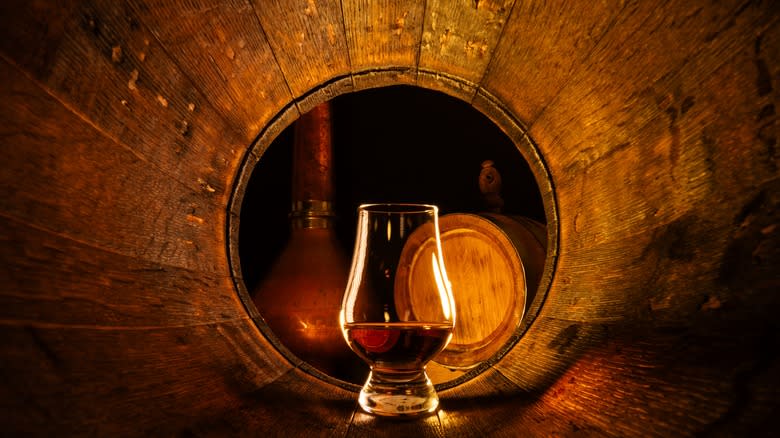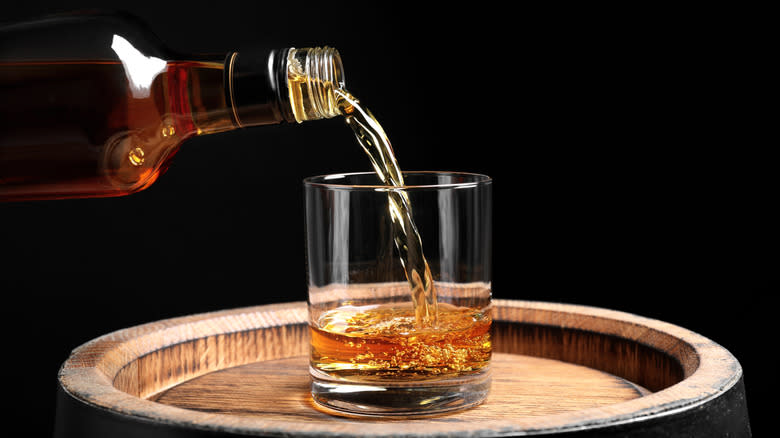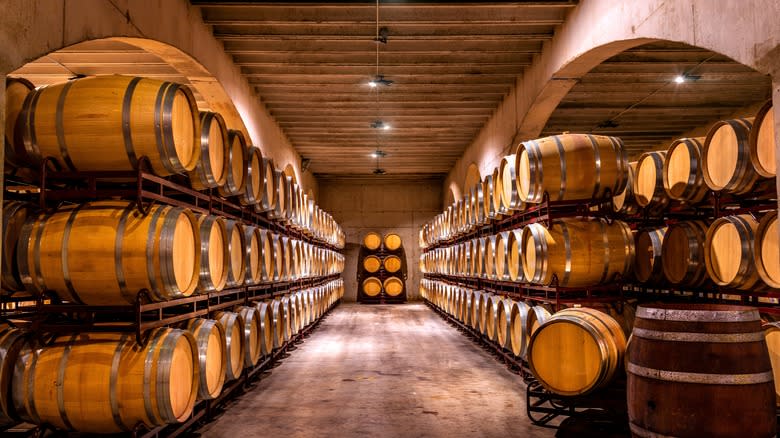How Many Bottles Of Whiskey Are In One Barrel?

We may receive a commission on purchases made from links.
How many snowballs in a blizzard? How many french fries are in a potato? How many bottles of whiskey in a barrel? These are just a few of the questions you may have asked yourself in those single-malt evenings spent in existential wonder. To answer the whiskey question –- there are quite a few bottles in a barrel. But as it is with most good things, it's a bit more complicated. On a good day (or rather, a good decade or two) for an average whiskey producer, that number is expected to be somewhere between 200 and 300 bottles per barrel.
The truth of how much whiskey exists in each barrel comes down to the whiskey-making process itself, which involves a series of calculations and executive decisions that inform the outcome of the spirit. Including (and central to our question) how much booze will end up in a wooden barrel at the end of 20 years. The beauty of this caramelly, smokey liquor is that it has a full life long before it ends up in a bottle.
Read more: 10 Of The Healthiest Beers You Can Drink
What Makes A Whiskey?

Whiskey is an umbrella term for many mashed-grain alcohols. A whisk(e)y can be anything from bourbon to rye to scotch (as well as a few others), mostly having to do with regional production methods and protocols. For instance, for bourbon to be called bourbon it must be American and made from at least 51% corn. Just about all whiskey is aged in wooden barrels, and as you might expect these barrels are as varied as the alcohol. Whiskey barrels are most commonly made of oak –- charred oak to be more specific –- and can be anything from plain American oak to sherry or port casks.
Of course, the type of barrel being used affects the volume of whiskey left in it when the aging process is done. This variable is not only due to any barrel's liquid volume capacity but for other features it might have. For instance, some barrels have different porosity depending on what they're made of: Smaller barrels will produce less whiskey at the end of its aging -- not just because they're smaller, but because of their liquid-to-wood ratio. The more wood there is in proportion to the whiskey, the more absorption and evaporation can occur over the spirit's life in the barrel.
Leave Her To Heaven

Since we're on the subject of evaporation, it's time to talk about the "angel's share". This is a term that refers to the amount of whiskey that is lost during the barrel aging process. Many conditions can affect just how much of the whiskey floats up to the heavens and how much stays in the barrel. It's mostly to do with the ambient environment in which the barrels are stored, but even treated consistently, the angel's share is a rather unpredictable thing and can vary from barrel to barrel; even from batch to batch using the same barrel.
Young whiskey evaporates the quickest, but as it ages will lose less volume. That being said, most spirits will decrease an average of 4% by volume every year, and by the end of a typical barrel aging nearly half the original volume could be lost. The bottom line is that there isn't one hard and fast number of bottles coming out of a barrel in any given batch. It's simply about the journey of the whiskey and the life of each barrel in every rickhouse. Ponder this, friends: don't worry about how many bottles of whiskey you can get from a barrel, only how many barrels of whiskey you can claim in a lifetime.
Read the original article on Daily Meal.

